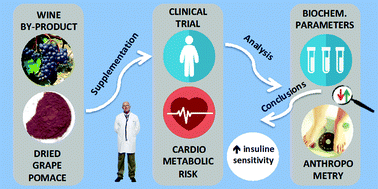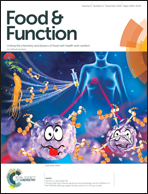A 6-week supplementation with grape pomace to subjects at cardiometabolic risk ameliorates insulin sensitivity, without affecting other metabolic syndrome markers†
Abstract
Grape polyphenols have shown a promising role in the modulation of metabolic syndrome (MetS), mostly in animal models. However, clinical studies are scarce and they usually only consider a fraction of polyphenols, ignoring the non-extractable polyphenols (high molecular weight compounds or associated with macromolecules such as dietary fibre). This study aimed at evaluating the effect of grape pomace, rich in both extractable and non-extractable polyphenols, on markers of MetS. Fifty subjects (22 women) aged 20–65 with at least two MetS factors were randomly assigned to the product (daily dose of 8 g of dried grape pomace) or to the control group in a 6 week crossover design with a 4 week wash-out. Samples were collected at the beginning and at the end of both periods; half of the participants were subjected to an oral glucose tolerance test at the beginning and the end of the supplementation period. Grape pomace supplementation significantly improved fasting insulinaemia (p < 0.01), without affecting other cardiometabolic risk parameters. A tendency towards an improvement in postprandial insulinaemia was observed, particularly in those subjects with higher fasting insulin levels. Therefore, supplementation with grape pomace may be a strategy for improving insulin sensitivity in subjects at high cardiometabolic risk.



 Please wait while we load your content...
Please wait while we load your content...